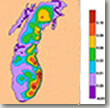 |
||||
We have reorganized our Research Programs. Most of the research projects from this program are now organized under the Ecological Prediction Research Program.

GLERL AQUATIC CONTAMINANTS and BIOGEOCHEMISTRY RESEARCH PROGRAMS
There are two primary components within this research program:AQUATIC CONTAMINANTS and BIOGEOCHEMISTRY
AQUATIC CONTAMINANTS RESEARCH
Task Leader: Peter Landrum
The Aquatic Contaminants Research Program combines process studies and mathematical modeling focused on toxic organic contaminants to increase our understanding of the dynamics and effects of pollutants in the ecosystem.
The purpose of this research is to 1) determine
processes that govern contaminant fluxes into and out of
sediments, that mix contaminants within sediments, and that
control the transfer of contaminants from sediments into the food
chain, 2) develop methods for assessing the extent or degree of
sediment contamination and for determining bioavailability and
bioaccumulation of sediment associated contaminants, and 3)
improve methods for interpreting the hazard of bioaccumulated
contaminants by developing the time-dose response relationships
based on accumulated body residue. ![]()
Current Projects
- Contaminant Effects: Investigations on the Utility of Body Residue as the Dose Metric.
- Sampling the Resuspendable Pool of Sediments and Associated Contaminants and Measuring Mass and Contaminant Fluxes in Lake Michigan Using Sediment Traps
- Bioavailability of Sediment-Associated Toxic Organic Contaminants
Recent Aquatic Contaminants Research Program Publications
(See also Complete List of
GLERL Publications)
2004
Hwang, H., S.W. Fisher, K. Kim, and P.F. LANDRUM. 2004. Comparison of the toxicity using body residues of DDE and select PCB congeners to the midge, Chironomus riparius, in partial-life cycle tests. Archives of Environmental Contamination and Toxicology 46:32-42.
LANDRUM, P.F., M. Leppanen, S.D. ROBINSON, D.C. GOSSIAUX, G.A. Burton, M. Greenberg, J.V.K. Kukkonen, B.J. EADIE, and M.B. LANSING. 2004. Comparing behavioral chronic endpoints to evaluate the response of Lumbriculus variegatus to 3,4,3´,4´-Tetrachlorobiphenyl sediment exposures. Environmental Toxicology and Chemistry 23(1):187-194.
LANDRUM, P.F., M. Leppanen, S.D. ROBINSON, D.C. GOSSIAUX, G.A. Burton, M. Greenerg, J.V.K. Kukkonen, B.J. EADIE, and M.B. LANSING. 2004. Effect of 3,4,3´,4´-Tetrachlorobiphenyl on the reworking behavior of Lumbriculus variegatus exposed to contaminated sediment. Environmental Toxicology and Chemistry 23(1):178-186.
2003
Burton, G. A. and P. F. LANDRUM. 2003. Toxicity of sediments. In Encyclopedia of Sedments and Sedimentary Rocks. G.V. Middleton, M.J. Church, M. Corigilo, L.A. Hardie, and F.J. Longstaffe (Eds.). Kluwer Academic Publishers, Dordrecht, 748-751. http://www.glerl.noaa.gov/pubs/fulltext/2003/20030008.pdf
Hwang, H., S. W. Fisher, K. Kim, P. F. Landrum, R. J. Larson, and D. J. Versteeg. 2003. Assessing the toxicity of dodecylbenzene sulfonate to the midge Chironomus riparius using body residues as the dose metric. Environmental Toxicology and Chemistry 22(2):302-312.
Ingersoll, C. G., E. L. Brunson, N. Wang, F. J. Dwyer, G. T. Ankley, D. R. Mount, J. Huckins, J. Petty, and P. F. Landrum. 2003. Uptake and depuration of nonionic organic contaminants from sediment by the oligochaete, Lumbriculus variegatus. Environmental Toxicology and Chemistry 22(3):872-885.Landrum, P. F., G. R. Lotufo, D. C. Gossiaux, M. L. Gedeon,
and J.-H. Lee. 2003. Bioaccumulation and critical body residue of
PAHs in the amphipod, Diporeia spp.: Additional evidence
to support toxicity additivity for PAH mixtures. Chemosphere
51:481- 489.
http://www.glerl.noaa.gov/pubs/fulltext/2003/20030002.pdf
Landrum, P. F., L. L. Sano, M. A. Mapili, E. Garcia, A. M. Krueger and R. A. Moll. 2003. Degradation of chemical biocides with application to ballast water treatment. NOAA Technical Memorandum GLERL-123. NOAA, Great Lakes Environmental Research Laboratory, Ann Arbor, MI, 37 pp. ftp://ftp.glerl.noaa.gov/publications/tech_reports/glerl-123/tm-123.pdf
Lozano, S. J., M. L. Gedeon, and P. F. Landrum. 2003. The effects of temperature and organism size on the feeding rate and modeled chemical accumulation in Diporeia spp. for Lake Michigan sediments. Journal of Great Lakes Research 29(1):79-88.
Nuurinen, S., P. F. Landrum, L. J. Schuler, J. V. K. Kukkonen and M. J. Lydy. 2003. Toxicokinetics of organic contaminants in Hyalella azteca. Archives of Environmental Contamination and Toxicology 44:467-475.
Wilcoxen, S. E., P. G. Meier, and P. F. Landrum. 2003. The toxicity of fluoranthene to Hyalella azteca in sediment and water-only exposures under varying light spectra. Ecotoxicology and Environmental Safety 54:105-117.
Yoo, L. J., J. A. Steevens and P. F. Landrum. 2003. Development of a new bioaccumulation testing approach: The use of DDE as a challenge chemical to predict contaminant bioaccumulation. EEDP Technical Notes Collection, ERDC/TN EEEDP-01-50. U.S. Army Engineer Research and Development Center, Vicksburg, MS, 11 pp. http://www.glerl.noaa.gov/pubs/fulltext/2003/20030006.pdf
BIOGEOCHEMISTRY RESEARCH
(Task Leader: John Robbins)
The Biogeochemistry Research Program is designed to help answer questions and address issues about the ecosystem's biogeochemical response to stressors.
Employ radioactive and stable isotopes to establish
geochronologies and probe major Great Lakes and coastal ecosystem
processes and their alteration by anthropogenic stresses such as
contamination and climatic variations, with emphasis on the
carbon and nitrogen cycles, and the use of natural and fall-out
radioisotopes.![]()
Current Project
This project is divided into the following sub-projects:
Recent Biogeochemistry Research Program Publications
(See also Complete List of
GLERL Publications)
Kerfoot, W. C., S. L. Harting, R. Rossmann, and J. A. Robbins. 2003. Elemental mercury in copper, silver, and gold ores: an unexpected contribution to Lake Superior sediments with global implications. Geochemistry: Exploration, Environment, Analysis 2:185-202 .
Cook, P. M., J. A. Robbins, D. D. Endicott, K. Lodge, P. D. Guiney, M. K. Walker, E. W. Zabel and R. E. Peterson. 2003. Effects of Aryl Hydrocarbon receptor-mediated early life stage toxicity on Lake Trout populations in Lake Ontario during the 20th Century. Environmental Science and Technology 37(17):3864-3877.
Past Aquatic Contaminants Projects
- Trophic Transfer of Atmospheric and Sedimentary Contaminants into Great Lakes Fish: Controls on Ecosystem Scale Response Times
- Bioaccumulation of Organic Contaminants by Diporeia spp.: Kinetics and Factors Affecting Bioavailability
- Measurement of Select Toxic Organic Contaminants in Surficial Sediments of Lake Michigan: Estimation of Lakewide Inventories and Seasonal Settling Fluxes
Past Biogeochemistry Projects
Last updated: 2004-05-15 jjs

